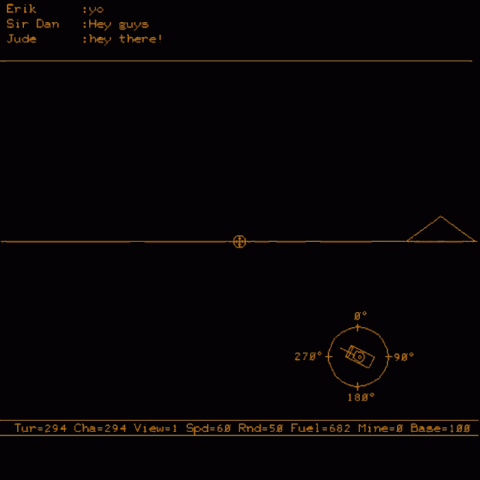Panther
created and published by Northwestern University in 1975, running on PLATO
type: racing/driving, shooter, simulation
perspective: 1st person
player options: Internet
languages: eng
perspective: 1st person
player options: Internet
languages: eng
Description
2 players, 3 players, 4 players, 5 players, 6 players, 7 players, 8 players, 9 players, 10 players, 11 players, 12 players, 13 players, 14 players, 15 players, 16 players, 17 players, 18 players, 19 players, 20 players, 21 players, 22 players, 23 players, 24 players, 25 players, 26 players, 27 players, 28 players, 29 players, 30 players, 31 players, 32 players, 33 players, 34 players, 35 players, 36 players, 37 players, 38 players, 39 players, 40 players, 41 players, 42 players, 43 players, 44 players, 45 players, 46 players, 47 players, 48 players, 49 players, or 50 players simultaneously in 2 teams of 1–49 players each. Actually the players were theoretically unlimited but 50 is the official record and the PLATO mainframe would max out at 1000 players (presuming no players were playing any other game or running any other application).
A tanks vs tanks simulator. Mixes scalable vector graphics to maintain a realistic 1st person perspective and raster graphics for animated effects that do not need to be shown in perspective (for a higher frame rate). Players would choose an name and join the squares or the triangles. They would maneuver around or over 5 randomly placed mountains of various sizes on a battle field of random size and try to eliminate the opposing team's base. Messages could be broadcasted by each tank to the other tanks. This was used for coordinating attacks, misleading the enemy, and trash talk. fuel and ammunition were limited by a resource/economic system. They could be acquired and traded between players at bases.
The terrain included rocks and trees and was randomly generated each round. A zoom feature (binoculars) was included. This was all done in real-time. This was a true 3D environment, nothing was shown infront of what it was supposed to be behind, objects could be partially obscured. Trajectory, vision, shooter's velocity, target's velocity, shooter's stance (how where the tracks resting on the surface), target's stance, distance, wind, and curvature of Earth were all factors that affected accuracy.
Atari had their very own PLATO terminal.
Requirements:
12 baud connection to the PLATO network and a graphical terminal.
 (Zerothis) - # 2008-09-22 05:27:39
(Zerothis) - # 2008-09-22 05:27:39
A tanks vs tanks simulator. Mixes scalable vector graphics to maintain a realistic 1st person perspective and raster graphics for animated effects that do not need to be shown in perspective (for a higher frame rate). Players would choose an name and join the squares or the triangles. They would maneuver around or over 5 randomly placed mountains of various sizes on a battle field of random size and try to eliminate the opposing team's base. Messages could be broadcasted by each tank to the other tanks. This was used for coordinating attacks, misleading the enemy, and trash talk. fuel and ammunition were limited by a resource/economic system. They could be acquired and traded between players at bases.
The terrain included rocks and trees and was randomly generated each round. A zoom feature (binoculars) was included. This was all done in real-time. This was a true 3D environment, nothing was shown infront of what it was supposed to be behind, objects could be partially obscured. Trajectory, vision, shooter's velocity, target's velocity, shooter's stance (how where the tracks resting on the surface), target's stance, distance, wind, and curvature of Earth were all factors that affected accuracy.
Atari had their very own PLATO terminal.
Requirements:
12 baud connection to the PLATO network and a graphical terminal.
Technical specs
display: raster
Authors / Staff
Tags (3)
other
software
vehicles
Related games
Contributors (4)
AndreaD
zerothis
Sanguine
Becoro
zerothis
Sanguine
Becoro


 Post an anonymous comment / review about this game
Post an anonymous comment / review about this game